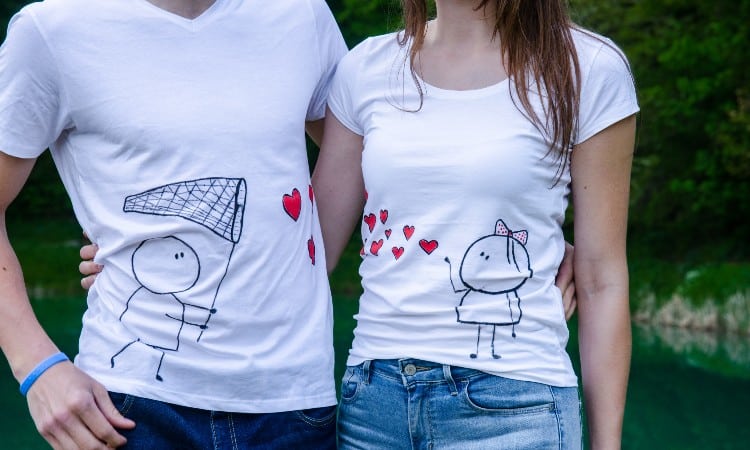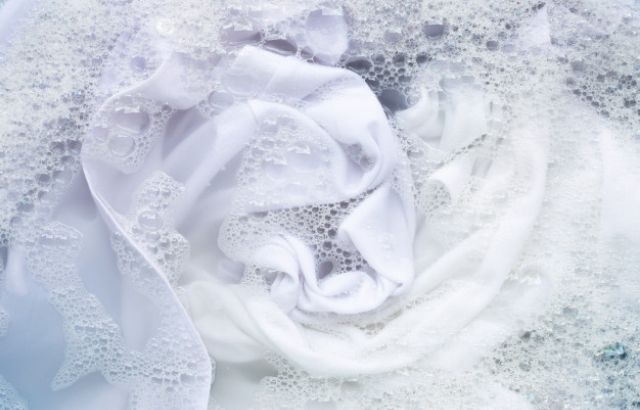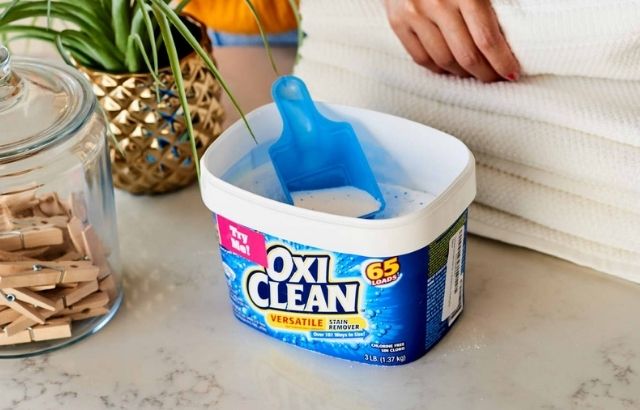It would help if you washed stains on white clothing with other light-colored clothing in cold water on a gentle cycle. Vinegar, oxygen bleach, and hydrogen peroxide are three of the numerous available brightening treatments. You can restore white garments by soaking them in lemon juice and allowing them to dry in the sun or by applying a paste of baking soda, Borax, and water. Before deciding how to wash white shirts with colored designs, check the label to see if it requires dry cleaning or if there are other special instructions.
How to Wash White Shirts with Colored Designs

Keeping your whites whiter is a constant battle, especially if you have a job that requires you to wear white shirts regularly. Even the smallest amount of dirt, food, or oils can leave your white shirt looking dingy and stained in no time at all. Keeping whites clean isn’t as hard as it sounds. With the right detergents and techniques, it’s quite simple! Keep reading to discover helpful tips for washing white shirts with colored designs.
- Use Pre-treatment method
- Use Immediate drying
- Use sunlight
- Keep loads small
- Washing Machine
- By Hand
- With Bleach
- Without Bleach
- Vinegar
- Baking Soda with Borax
- Commercial Products
- Use color-safe detergent
Use Pre-treatment method
For stains, the pre-treatment regime is the path to follow. If you are going to put a stained garment in the washing machine, remember to put liquid detergent first, a paste made of powdered detergent and water, or a pre-treatment bar or spray directly on the stain.
A five-minute rest is necessary and up to many hours, depending on the particular product’s standards and the stain’s stubbornness. You can add some bleach, detergent, or pure soap into a bucket of water and soak the item.
Use Immediate drying
Both white and colored clothes need to dry the clothes after the washing machine stops instantly. Wet clothing placed in the machine can end up building up mold or fungus, which are not only unsightly and smelly but also harmful to your health.
Use sunlight
Drying in sunlight can make linens even whiter. Natural fabrics are mainly favored by the whitening characteristics of the sun’s rays. In the end, the sad thing is that some stained or aged white clothing will stay this way.
Even special efforts in special conditions sometimes have the possibility of failing to return your white dress to its old glory. In this situation, the best thing you can do is to assume in the future: if you love that dress and you will cry if it is not cleaned, get two.
Keep loads small
The chances are high that it will release more dirt and grime during washing. When the soil enters the water, it will occasionally settle back onto the clothing. In short, you don’t want to mission enough in your washing machine. Also key: wash the visible ones only with other visible ones.
Abrasion by agitation breaks the area of the shirt and causes small fibers to stick out. Remember to turn the shirts over before putting them in the washing machine. This will help you keep the front of your sweater longer.
Now, add a detergent with a bleaching agent and select water that is not too hot. “Hot water damages clothes faster than warm water.”
Washing Machine
The best way to avoid yellowing when washing whites with color is to use your washing machine and adhere to a few simple guidelines. Please check your washing machine’s settings if you haven’t already. You should be able to control the temperature of the shower water. On some devices, you can find a simple control knob with hot, warm, and cold settings. Some more sophisticated models even allow you to adjust the temperature manually.
Sheets are an example of a white that can withstand washing in hot water. Utilize the dryer to eliminate stubborn dirt and grime from stained garments. In contrast, hot water causes irreversible damage to fabric fibers and accelerates deterioration.
By Hand
You shouldn’t use bleach on white garments because it significantly fades printed designs. Professional laundries no longer employ chlorine bleach because of health concerns. Oxygen bleach is sodium percarbonate. This bleach produces hydrogen peroxide when combined with water.
With Bleach
Bleach can significantly fade the colors in printed designs, so avoid using it on white clothing. Modern laundry professionals generally avoid chlorinated bleaches. Sodium percarbonate is the main component of oxygen bleach. This bleach produces hydrogen peroxide when it reacts with water.
Without Bleach
Hydrogen peroxide is an excellent substitute for bleach if you are thinking about not using this product. You can use peroxide or hydrogen to disinfect and bleach laundry.
Vinegar
You can eliminate musty odors and brighten specific white garments. Vinegar’s acetic acid revives cotton garments’ color without compromising their dyed or printed patterns. However, it is less effective than other substances. Particularly effective at removing underarm stains from T-shirts is vinegar.
Baking Soda with Borax
This combination is between two standard household products that you can use to brighten colored whites. Due to their alkaline properties, they can effectively remove fabric stains and clothe’s yellowing.
Commercial Products
In certain instances, you can use commercial products such as color grabbers or laundry boosters to mix various colors in the laundry. During the washing process, color grabbers marketed under brand names like Shout are designed to attract and collect stray dye particles. In this manner, the dye will not transfer to other garments.
Use color-safe detergent
The optimal way to combine colors and whites in the washing machine depends on the fabric of the cleaned items. The load containing colorfast items should be treated as a white load. If your whites contain spandex or a multicolored pattern, you should wash them without bleach because they are technically a color.
How to Dry your White Shirts?

It is best to dry cotton on a shorter cycle, remove it while it is still damp, and hang it to dry to prevent it from deteriorating and yellowing. You can also remove wrinkles with a low-heat iron setting. However, the most efficient method is to hang your whites outside in the sun. The sun’s ultraviolet rays will accelerate the bleaching of your white clothing. If you’d instead not try that, machine drying is a viable alternative. Follow these simple instructions for machine drying whites to maximize your dryer’s performance.
Laundry Tips to Keep White Clothes White

Respond Immediate to Spills
If you want to keep your whites white, it should go without saying that you must treat stains as soon as they appear.
Spot-treat the neckline, sleeves, and hem of the garment.
While spilled food, drink, or makeup may seem obvious, dirt on collars, cuffs, and hems is often neglected.
Pay Close Attention to What You Feed Your Body
In addition, the residue left behind by our personal care products makes white clothing appear dingy. White clothing can have stains from deodorants, antiperspirants, lotions, sunscreens, self-tanners, cosmetics, hair products, and other personal care products.
Avoid using dye transfer.
Not only personal care products can transfer onto white clothing and cause stains. White clothing is particularly susceptible to staining and fading from the dyes of other garments.
Do not overuse detergents and bleaches.
Contrary to popular belief, using more laundry detergent does not result in cleaner clothes. The accumulation of laundry detergent, liquid fabric softener, in-wash products like scent beads, and whiteners like oxygen bleach can dull whites.
Utilize a laundry whitening booster.
Laundry boosters, an umbrella term for various products designed to be used in conjunction with laundry detergent, are an excellent way to preserve the whiteness of your whites. Oxygen bleach, Borax, and baking soda are helpful as additional whiteners during wash days.
Avoid plastic containers.
You should take certain precautions to prevent yellowing when storing white clothing for the long or short term.
How to Wash White Clothes with Stains
Need assistance removing stains from white clothing? Remember the following procedure:
- A quality detergent should wash whites in the warmest water possible without causing fabric damage.
- Use baking soda or white vinegar to eliminate the remaining stains.
- Bleaching with a diluted solution can eliminate stains from plain fabrics. We don’t recommend attempting this with delicate materials.
- To remove yellow sweat stains from white clothing, soak them in diluted bleach, lemon juice, or white vinegar.
White clothing is always fashionable, regardless of who wears it, until it becomes soiled. When stained, whites are more noticeable and often more difficult to remove than darks. Fortunately, if you follow our advice and learn to remove color stains from white clothing, a splash of tomato sauce or a yellow sweat mark won’t ruin your favorite white garments.
How to Wash a White Shirt with Black Sleeves
Use hydrogen peroxide, vinegar, or bleach to prevent the black from bleeding into the shirt’s white portion during washing.
A common issue with predominantly white or black garments is that the black dye goes to the garment’s white parts during washing, turning them into a dirty grey color. Initially, wash them with cold water. This can help prevent this from occurring.
Follow the manufacturer’s instructions and add a half cup of white vinegar or hydrogen peroxide to the load to maintain the fabric’s crispness and brightness.
Things to Avoid While Washings white Shirts with Colored Designs
Because there are factors other than garment color, the decision to combine light and dark loads is more nuanced. The garment’s fabric is nearly as important as the garment itself, if not more so.
Since different fabrics respond favorably to various washing procedures, the washing machine in your home likely has a variety of settings. The most intuitive reason for separating dark and light clothing is the concept of “color spread.” When you wash particularly dark or brightly colored garments, some of the dye will likely run off into the water.
Sorting your laundry is essential if you are washing many new items. Because they contain more dye, this issue will initially be more apparent.
In addition, sorting by fabric will aid in preventing shrinkage. You cannot wash certain items in hot water or a hot dryer. You should also avoid frequently combining different types of materials. Due to the added weight and friction, if you combine a large number of denim jeans with a few lightweight cotton tops, the denim will likely rip, and the tops will likely become squished.
How to Bleach Colored Clothes White
/how-to-bleach-clothing-white-1106366-01-dc66ca7e93ca47b3b71a4fe9d86583b8.jpg)
Before dying or washing a cotton garment, you must ensure that it will behave as expected. Dilute two teaspoons of bleach with a quarter cup of water to treat an inconspicuous area of an item.
You may need to experiment with various bleach concentrations before settling on the most effective one. Mix one bleach with four or five water parts to create a solution. Bleach must always be diluted to avoid damaging clothing, causing skin irritation, and destroying subsequent loads of laundry. Before washing and drying with paper towels, wait one minute. If there is no visible color fading, the item is considered colorfast.
If you only want a small portion of a piece of clothing to be lighter than the rest, bleaching is the way to go. Use a spray bottle to achieve a splattered appearance on your jeans without damaging them. Place objects, such as leaves or stencils, on the fabric before applying bleach to prevent the color from absorbing.
Tricks to Wash White Shirts with Colored Designs
The Dry-Shirt Drying Trick
A handheld hairdryer is ideal for quickly and thoroughly drying your clothes. After wringing the laundry:
- Spread it out.
- Dry each article of clothing with hot or warm air while holding the hairdryer close to the garment.
- Turn the item inside out and rotate it frequently as it dries.
The Steam Shower Trick
- Place your garments on a hanger and drape them over the shower rod to dry.
- After hanging your garments on the shower rod, examine them for defects.
- Next, the steamer will be ignited. Turn on the shower and ensure that the water is as hot as possible to create a steaming effect for optimal results in removing wrinkles from clothing.
- A quick steam in the shower can transform clothes miraculously, but only if you keep a close eye on them throughout the process.
The Microwave Trick
The oven can be used as a clothes dryer. Using this method, small clothing items such as socks and underwear dry quickly, but the entire load can take up to an hour. If you insist on trying, place your small items on a baking sheet and preheat the oven to 100 degrees. Once the oven reaches the appropriate temperature, please turn it off and place the baking sheet inside.
Because this method may be unsafe for your oven, it is recommended that you wring out the clothes before placing them inside.
The Super Speed Dryer Trick
Read the care instructions carefully if you don’t want to ruin your clothes. In addition to being a bad idea, overdrying your clothes can damage the fabric. Utilize the dryer’s automatic setting to have it shut off when the clothes are dry.
The best way to dry clothes without causing them to shrink is to dry them in the sun outside. However, if you live in a perpetually damp climate, you should dry your clothes in a low heat setting. Take them out of the dryer and hang them on a rack to dry.
Frequently Asked Questions
Can I wash different colors in cold water?
Coldwater is suitable for most clothes and other items you can put safely in the washing machine. It can remove many stains from clothes, including grass on your child’s jeans or makeup stains on a sweater. Delicate fabrics (lace and silk) and dark, colorful fabrics work best in cold water anyway.
Do you wash whites in hot or cold water?
For the most part, in very shabby clothes, towels and bedding, linens should be washed in water that is not too hot or burning. Still, there are some exceptions: fabrics with transparency or delicacy, such as lingerie and swimwear, need lower temperatures, while stains such as blood, wine, and coffee have the possibility of hardening if washed in water not too hot or burning.
Can you wash white clothes with color detergent?
Most American detergents have enzymes inside to remove stains and perhaps oxygen bleach that does not fade colors. American laundry detergents are acceptable for both whites and colors.
Using white powder a few times is not going to be a problem. But in the long run, the white powder detergent is quite warlike and will start whitening and “removing color” from brightly colored clothes. If you mix your clothes, the highlight is to use colored powders because they are less warlike.
Kerr recommends an alternate procedure for regular care: “Use an optimal laundry detergent coupled with a laundry bleach maximizer but be sure not to overdose your laundry products. Laundry detergent build-up will create that grey facade in whites over time. Your choices? Tide Ultra Stain Release for detergent and OxiClean White Revive or Borax for enhancers.
How often should your shirts be washed?
After wearing a shirt or blouse a few times, dress pants or slacks are no longer appropriate for formal occasions after two or three washes. Jeans can be worn six times over an undershirt after four or five washes, but only once or twice on their own.
Tank tops, camis, and tees should be laundered after every wear. Outerwear, such as dress shirts and khakis, can be worn multiple times before washing unless it is sweltering, you are sweating profusely, or the item is visibly dirty or stained.
Can You Use Bleach on White Shirts With Designs?
There is a good chance that you can bleach a white shirt with an embroidered logo safely. Before testing the embroidery thread’s colorfastness, the shirt’s fabric must be bleach-resistant. In conclusion, bleach is ineffective on screen-printed apparel. Bleach can alter the hue and hasten its demise. Bleach contains agents that can change the hue of both fabric threads and screen printing dyes.
Can You Wash White Clothes with Colors in Cold Water?
In cold water, you can mix your whites and colors. If you wash your clothes in cold water rather than hot water, they will last significantly longer.
Washing with hot water can eliminate bacteria and germs. You can add bleach to a white load to disinfect it, but only if the entire load is white. However, cold water should be utilized when washing colors. This will prevent excessive dye transfer, preserving the color and protecting your other garments.
Can you wash and dry colors and darks together?
We don’t suggest washing items of different fabrics and colors simultaneously. You should clean dark and bright colors in cold water separately. When clothes are washed in cold water, the color transfer is reduced. It may seem convenient to dry everything at once, but this is not a good idea, mainly if any colors are not colorfast. Even after multiple washes, dye transfer from wet dark or colorful garments to white or light-colored fabrics occurs in the washing machine and the dryer.
Can you wash white clothes in light colors?
If you do not want colors to transfer to whites, wash colors and whites separately. For instance, if you have light grey clothing, you can wash it with whites, but you should separate dark grey apparel.
People can wash whites and other light-colored items together. You can use white, light greys, and white background patterns with pastel blues, pinks, greens, lavenders, oranges, and fuchsias.
Expert Opinion
Nowadays, different procedures give you the option of having incredible results in stains or generalized dirt in multicolored items.
For stains, a laundry pre-treatment spray such as Zout or colorless bleach will do the trick, while oxygenated bleach can be used to illuminate a striped shirt that has turned a little grey. And if the bad thing happened and your red, navy blue, or wash white shirt with black sleeve stripes has faded into white, Carbona makes a product called Color Run Remove that can reverse that.
When washing the socks, it’s not a requirement that you separate them from other types of clothing. However, it is a requirement to split different colors of pantyhose. Among other things, when you see white sports socks, you have to wash them with other whites such as underwear, white T-shirts, or other mainly white clothing. Hope you have learned how to wash white shirts with colored designs.
Read More: How to Clean Up Spilled Laundry Detergent




